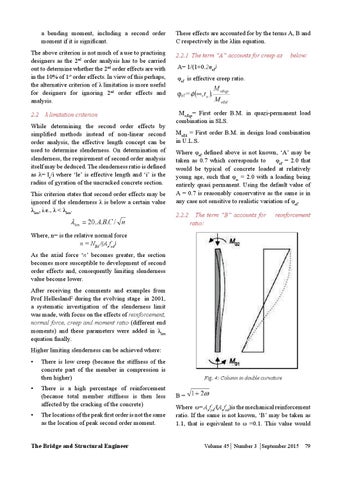a bending moment, including a second order moment if it is significant.
These effects are accounted for by the terms A, B and C respectively in the λlim equation.
The above criterion is not much of a use to practising designers as the 2nd order analysis has to be carried out to determine whether the 2nd order effects are with in the 10% of 1st order effects. In view of this perhaps, the alternative criterion of λ limitation is more useful for designers for ignoring 2nd order effects and analysis.
2.2.1 The term “A” accounts for creep as
2.2
MoEqp= First order B.M. in quazi-permanent load combination in SLS.
λ limitation criterion
While determining the second order effects by simplified methods instead of non-linear second order analysis, the effective length concept can be used to determine slenderness. On determination of slenderness, the requirement of second order analysis itself may be deduced. The slenderness ratio is defined as λ= le/i where ‘le’ is effective length and ‘i’ is the radius of gyration of the uncracked concrete section. This criterion states that second order effects may be ignored if the slenderness λ is below a certain value λlim, i.e., λ < λlim.
below:
A= 1/(1+0.2øef) φef is effective creep ratio.
MoEd = First order B.M. in design load combination in U.L.S. Where φef defined above is not known, ‘A’ may be taken as 0.7 which corresponds to φef = 2.0 that would be typical of concrete loaded at relatively young age, such that φ∞ = 2.0 with a loading being entirely quasi permanent. Using the default value of A = 0.7 is reasonably conservative as the same is in any case not sensitive to realistic variation of φef. 2.2.2
The term “B” accounts for ratio:
reinforcement
Where, n= is the relative normal force n = NEd /(Acfcd) As the axial force ‘n’ becomes greater, the section becomes more susceptible to development of second order effects and, consequently limiting slenderness value become lower. After receiving the comments and examples from Prof Hellesland2 during the evolving stage in 2001, a systematic investigation of the slenderness limit was made, with focus on the effects of reinforcement, normal force, creep and moment ratio (different end moments) and these parameters were added in λlim equation finally. Higher limiting slenderness can be achieved where: •
There is low creep (because the stiffness of the concrete part of the member in compression is then higher)
•
There is a high percentage of reinforcement (because total member stiffness is then less affected by the cracking of the concrete)
•
The locations of the peak first order is not the same as the location of peak second order moment.
The Bridge and Structural Engineer
Fig. 4: Column in double curvature
B= Where ω= Asfyd/(Acfcd)is the mechanical reinforcement ratio. If the same is not known, ‘B’ may be taken as 1.1, that is equivalent to ω =0.1. This value would Volume 45 Number 3 September 2015 79
